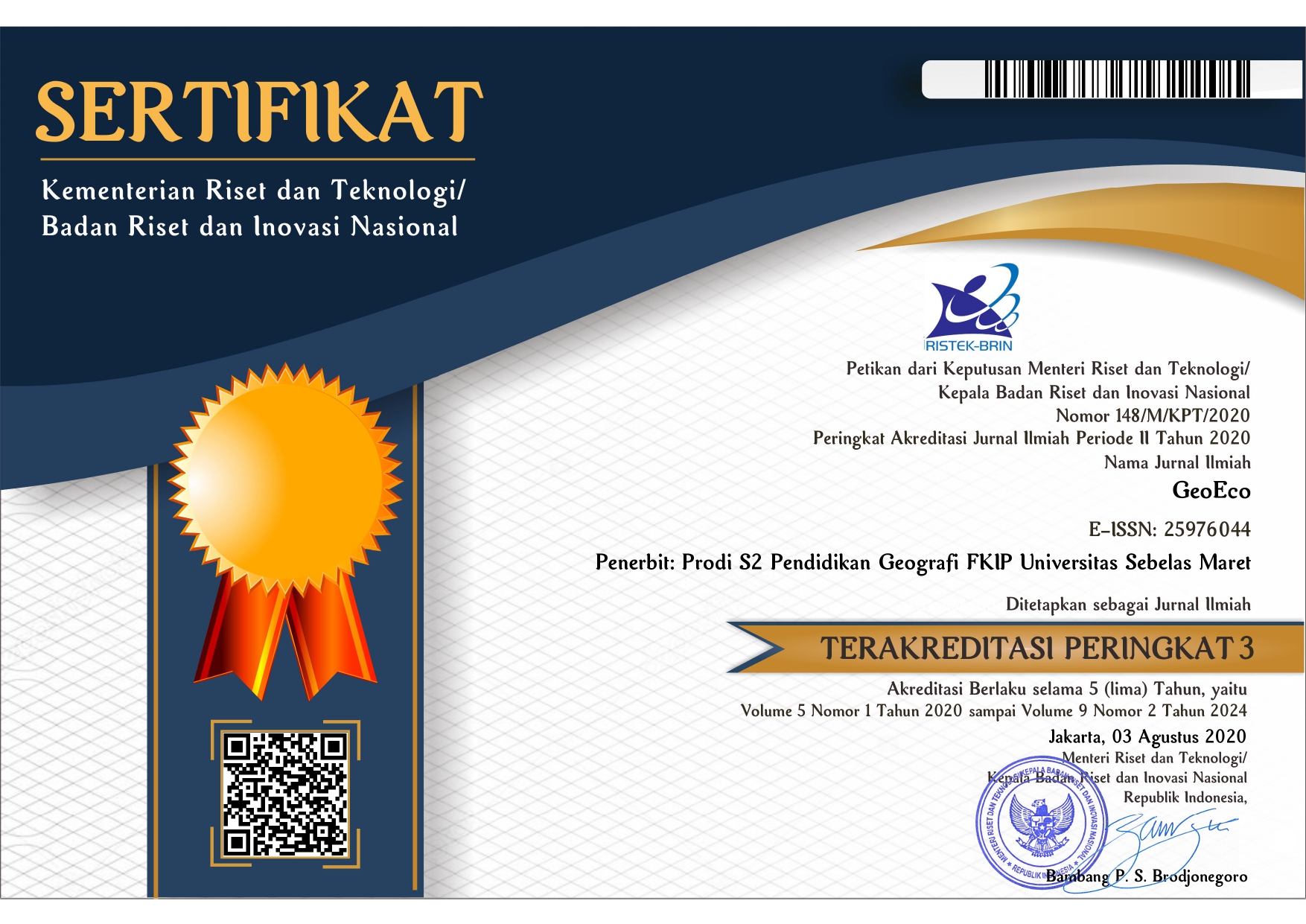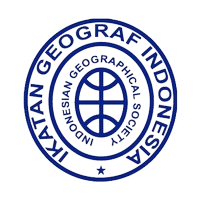RIVERBANK EROSION IN PART OF TIBO VILLAGE, DONGGALA REGENCY
Abstract
This study aims to identify riverbank erosion in some Tibo villages, Sindue Tambusabora District, Donggala Regency. This type of research is descriptive qualitative with a spatial approach. The data analysis technique used in this study includes a qualitative descriptive analysis in the form of a unit analysis of the area of landform from the fluvial process in Tibo Village, Sindue Tambusabora District, Donggala Regency. The data used in this study include primary data and secondary data. Primary data are the results of field ground checks and direct measurements, while secondary data are Landsat 8 OLI images and RBI maps of 1:50,000 scale 2015-65. This type of research is descriptive qualitative with a spatial approach. The data analysis technique used in this study includes a qualitative descriptive analysis in the form of a unit analysis of the landform area from which the fluvial process originated in the village of Tibo. Mild to moderate erosion and sedimentation rates. Erosion of cliffs is very high, especially at the bend of the river where erosion occurs due to high river discharge so that many charred rivers are found in Tibo village due to high erosion and sedimentation.
Keywords
Full Text:
PDFReferences
Aldhila Gusta H.Y dan Widiyanto. (2016). Kajian Kerawanan Longsor Tebing Sungai Code Daerah Istimewa Yogyakarta (Studi Kasus : Penggal Sungai Code Antara Banteng-Gondolayu). Jurnal Bumi Indonesia, 5(2), 1–10. Ardiansyah, T., Lubis, K., & Hanum, H. (2013). Kajian Tingkat Bahaya Erosi Di Beberapa Penggunaan Lahan Di Kawasan Hilir Daerah Aliran Sungai (Das) Padang. Jurnal Agroekoteknologi Universitas Sumatera Utara, 2(1), 97617. https://doi.org/10.32734/jaet.v2i1.5861 Asdak, C. (2007). Hidrologi dan Daerah Aliran Sungai. Gadjah Mada University Press. Atkinson, P. M., German, S. E., Sear, D. A., & Clark, M. J. (2003). Exploring the relations between riverbank erosion and geomorphological controls using geographically weighted logistic regression. Geographical Analysis, 35(1), 58–82. https://doi.org/10.1111/j.1538-4632.2003.tb01101.x Das, T. K., Haldar, S. K., Sarkar, D., Borderon, M., Kienberger, S., Das Gupta, I., Kundu, S., & Guha-Sapir, D. (2017). Impact of riverbank erosion: A case study. Australasian Journal of Disaster and Trauma Studies, 21(2), 73–81. Imam Hardjono, R. W. (2016). Identifikasi Lahan Pertanian Di Dataran Fluvial Wilayah Kabupaten Kulonprogo Dengan Menggunakan Aplikasi Sistem Informasi Geografi Dan Penginderaan Jauh. The 3rd Universty Research Colloquium, 56–69. Irawan, L. Y., Yulyanto, A., Nailatus, E., Setiawan, F. M., & Langsung, M. T. (2020). Identifikasi bahaya longsor lahan di sebagian wilayah poncokusumo dan wajak kabupaten malang. Geodika: Jurnal Kajian Ilmu Dan Pendidikan Geografi, 4(2), 160–171. https://doi.org/10.29408/geodika.v4i2.2474 Kummu, M., Lu, X. X., Rasphone, A., Sarkkula, J., & Koponen, J. (2008). Riverbank changes along the Mekong River: Remote sensing detection in the Vientiane-Nong Khai area. Quaternary International, 186(1), 100–112. https://doi.org/10.1016/j.quaint.2007.10.015 Lihawa, F. (2009). Pendekatan Geomorfologi Dalam Survei Kejadian Erosi. Jurnal Pelangi Ilmu, 2(5), 1–18. Nardi, L., Campo, L., & Rinaldi, M. (2013). Quantification of riverbank erosion and application in risk analysis. Natural Hazards, 69(1), 869–887. https://doi.org/10.1007/s11069-013-0741-8 Noor, D. (2014). Geomorfologi. Deepublish. Pattison, I., & Lane, S. N. (2012). The link between land-use management and fluvial flood risk: A chaotic conception? Progress in Physical Geography, 36(1), 72–92. https://doi.org/10.1177/0309133311425398 Raharjo, P. D. (2013). Penggunaan Data Penginderaan Jauh Dalam Analisis Bentukan Lahan Asal Proses Fluvial Di Wilayah Karangsambung. Jurnal Geografi Media Informasi Pengembangan Ilmu Dan Profesi Kegeografian, 10(2), 167–174. Rahman, M. (2013). Impact of Riverbank Erosion Hazard in the Jamuna Floodplain Areas in Bangladesh. Journal of Science Foundation, 8(1–2), 55–65. https://doi.org/10.3329/jsf.v8i1-2.14627. Saadon, A., Abdullah, J., Muhammad, N. S., Ariffin, J., & Julien, P. Y. (2021). Predictive models for the estimation of riverbank erosion rates. Catena, 196(October), 104917. https://doi.org/10.1016/j.catena.2020.104917 Soetoto. (2019). Geomorfologi. Ombak.Yogyakarta. Sutikno, Suparpto Dibyosaputro, E. H. (2019). Geomorfologi Dasar Bagian 1. Gadjah Mada University Press. Wulandari, F. (2021). Analysis Of Community Preparedness Facing Erosion Disaster In Sambas Regency. GeoEco, 7(2), 6.
Refbacks
- There are currently no refbacks.












.png)

